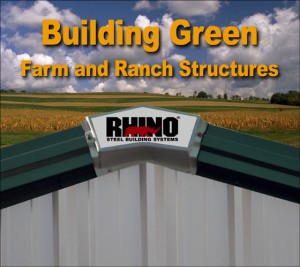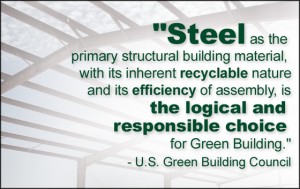Why Farmers and Ranchers Choose Pre-engineered Steel Buildings
People who enjoy country living favor building green, eco-friendly structures on their rural properties.
Whether their country home represents a retreat from urban life or their livelihood, rural dwellers love the land. Country people are, by nature, conservationists. Environment preservation is important to them, and so is eco-friendly green building.
Farmers and ranchers were the first to appreciate and build with steel. Even before the environmental movement gained national support, those who made their living from the land recognized the advantages of building eco-friendly steel barns and steel agricultural support structures.
 Steel Buildings: The Right Choice for Rural Structures
Steel Buildings: The Right Choice for Rural Structures
Pre-engineered metal buildings offer farmers, ranchers, and other rural residents many advantages.
Quite simply, green building with steel delivers the best deal for the planet, the pocketbook, and for the people purchasing the structure. Here is why:
RECYCLED: Steel is the most recycled material on Earth. Every year, America recycles 80 million tons of steel.
Steel is 100% recyclable. Steel is the only construction material which never loses any of its characteristic strength when recycled repeatedly.
 The U.S. Green Building Council states, “Steel as a primary structural building material, with its inherently recyclable nature and its efficiency of assembly, is the logical and responsible choice for Green Building.”
The U.S. Green Building Council states, “Steel as a primary structural building material, with its inherently recyclable nature and its efficiency of assembly, is the logical and responsible choice for Green Building.”
Steel is the only building material in the LEED (The Leadership in Energy & Environmental Design) green building program with an automatic minimum default for its high-recycled content.
North American iron and steel makers started recycling over 150 years ago. All new steel framing now contains recycled steel.
The magnetic properties of iron and steel allow them to be handled easily— and separated from the solid waste stream effortlessly— with large electromagnets.
Every ton of steel recycled saves 4,500 pounds of raw iron ore, and 1,400 pounds of coal, and 120 pounds of limestone over creating virgin steel.
Recycling steel saves enough energy annually to provide power to over 18 million homes.
STRENGTH: No other building material matches the strength-to-weight ratio of steel.
Steel’s strength lets pre-engineered metal buildings to span farther for greater maneuverability of large farming equipment.
The reliability and predictability of inorganic steel components allow designers and engineers to create the strongest structure with the least amount of material.
DURABILTY: Prefab steel buildings last decades longer than wood-framed structures. The longer the building lasts, the less the impact on the environment— and the more money it saves the owner.
Steel buildings also hold their value better than wood structures. (In fact, farmers and ranchers may find pole barns actually decrease the value of their property!)
Simple to maintain, prefab steel buildings do not require the constant painting and care of wood structures.
LESS WASTE: Rural people hate waste. Pre-engineered steel buildings create much less waste than lumber-framed structures.
Pre-engineered metal buildings need fewer pieces to create a more stable structure. Prefabricated metal buildings erect quickly and easily. Hands-on, do-it-yourselfers by nature, many rural metal building owners erect their own structures. They save money— and enjoy the bragging rights.
Wood and other construction materials end up dumped into landfills at the end of their lifecycle. Each year Americans builders dump over 136 million tons of construction debris into straining U.S. landfills.
At the end of the structure’s usefulness, construction steel lives on, recycled into cans, cars, bridges, ships, railroads, large appliances— or possibly another metal barn or ag building.
HEALTHIER: Untreated wood structures invite termites to dinner.
Wood treated with harsh chemicals discourages termites, but outgasses into the air to be inhaled by people and livestock. Wood-treated chemicals also leech into the ground and water table.
Livestock gnawing on treated wood framing ingests these harsh chemicals— and damages the wood framing.
Mold grows rapidly in the humid environment of structures full of animals, especially with an organic material like wood to provide fuel for mold spores. Mold and fungus create unhealthy air quality, increasing the chance for respiratory illnesses in both livestock and people.
As an inorganic material, steel never supports mold growth or rot. Steel never outgasses. Termites cannot chew on steel framing— and neither can livestock.
Every metal barn and rural structure built with steel instead of wood means more living trees in the forests of our planet. Trees clean our air, removing contaminants and producing life-giving oxygen. That fact alone should be enough motivation to build green with steel.
FIRE: Every rural resident fears fire. Rural fires spread quickly, destroying what it has taken a lifetime to create. In farm and ranch buildings containing highly flammable hay or fertilizer, a fire may quickly become an inferno.
Wood framing is often the initial site of ignition in a structural fire. Regardless of the point of ignition, wood framing certainly provides fuel for a fire.
Steel is non-combustible. It never adds fuel to a fire. Steel is never the point of ignition in a fire.
Lightning, another fire hazard, is more likely to damage wooden pole barns and other wood rural buildings than metal structures. In a properly grounded steel building, lightning passes harmlessly into the ground.
Most insurance companies offer large premium discounts for steel framing, primarily because of the non-combustible nature of steel.
RHINO Steel Buildings: The Right Choice Every Time
Building green with RHINO Steel Building Systems not only helps conserve natural resources, but also saves nice, green money. Now that is a win/win proposition for all farmers, ranchers, and rural landowners.
Do you want more details about green building in the country?
Call RHINO today at 940.383.9566 for more information on eco-friendly and economical green barns, hay sheds, equipment storage, riding arenas, and other steel farm buildings.
